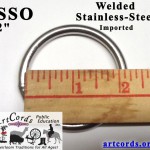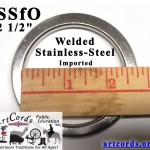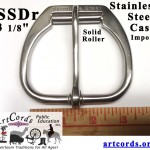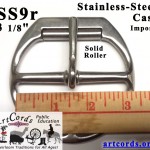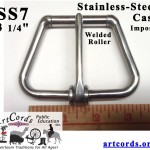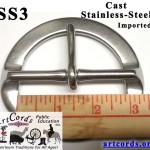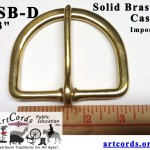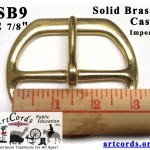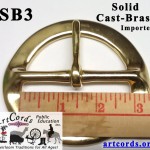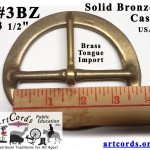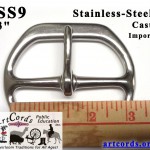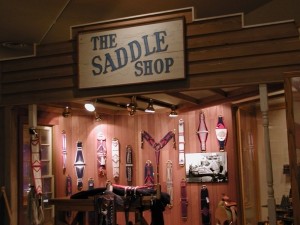
Presentations on cinch & rope making have often been conducted in the Buffalo Bill Museum Gallery, Cody, Wy
While demonstrating cinch making in the Buffalo Bill Museum Gallery in Cody, Wyoming in 1997, visitors from Germany could be heard whispering among themselves as I was describing the function of the cinch. One of them raised a hand and said,”direct English translation from German is ‘Belly Belt'”. Talk about a literal translation!
So when we are speaking of the ‘belt’ it would be understood that a buckle is also part of the picture.
Everything pretty much ‘hinges’ on the buckles given the role they play in function of the cinch and girth. Though they vary considerably in shape and size, all are designed for the same purpose… the attachment point between the strap holding it to the saddle, and whatever material has been chosen for the strap under the animal.
This functional role places the rings or buckles it in a most important position for decided quality and comfort. Of course, the material of choice for the cinch body extends between each buckle, posing unique results to be addressed in more depth at another time. It is worth noting that buckles may differ somewhat on each end of the cinch material depending on what form of attachment is chosen by billet and/or latigo for each side of the saddle. For example some folks have adopted use of a roller buckle for the on-side and a different shaped non-roller when using an off-side billet. Having matched buckles with use of latigo on both sides allows certain cinches to be rotated end-for-end to help prevent elbow wear patterns and/or contribute to greater comfort and performance in certain situations.
Some folks find more confidence, citing safety considerations, for always tying up both sides with latigo straps rather than depending wholly on the holes in the leather straps. In such a case they may go with a simple ring if not using straps with holes. Others use the latigo with holes to secure the metal tongue, also called ‘tang’ or ‘prong’ among other names, especially helpful since the vast majority of cinches today only have buckles with tongues. The tongue can assist in keeping the buckle centered on the latigo in some cases.
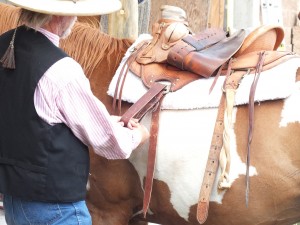
Farrier/Cinch Maker Lloyd Britton explains helpful pointers for latigo use in the 1st Video Episode of “For the Equine’s Sake”
However, no matter now carefully strand tension has been applied in making the cinch, even the buckles may still rotate to adjust for the angles and contour of the cinch groove. This also may include how the fatty tissues have been molded by pressures from previous cinch use, thus contributing to forces placed on the buckle by the body strands. Keeping an eye on this, especially to ensure the rotated buckle is not causing undue pressure and discomfort is advisable.
A word of caution: Leaving the tongue unsecured by the leather can be a bit of a hazard as many tongues tend to ‘open’ sticking out from the buckle. If this places it in a position to be bumped by the stirrups, the pressure and potential combination of movement could lend itself to discomfort and pain.
Securing the buckles themselves and the related considerations will be best covered at another time. This article at least gives you some thoughts on what has been observed and might be of help in your situation.
Below are a number of the buckles and rings being offered in the past few years. Some of the styles have been around since casting metal became common, while other are much more contemporary with improvements or modifications in the past few years. We show them here with a ruler for inside diameter width reference. Although this is most helpful for cinch makers, the measurement reference also will be an important consideration, coming into play more-so when we address cinch width.
Please note that the most common inside diameter of cinch buckles today is close to 3 inches. Another page will address the truly made in USA hardware in greater depth as funding allows.
(Click on each image for a larger photo)
Given the fact that a vast majority of cinch buckles available today are only available as imports, this visual representation also helps everyone more easily identify counterfeit cinches on the market. This is especially helpful when appropriately determining fair-market values because any cinch claiming “Made in USA” in advertising and/or labeling/tags, is required to identify components “one-step-back” which are imported. Simply look at the labels of tools in the hardware store, on your next visit, to see what this accurate labeling looks like… Just remember, if a seller is failing to correctly identify the imported components just,”because it sounded good” then you may do well to search a little further and support those you find who are taking the time for due diligence in labeling in compliance with consumer protections.


